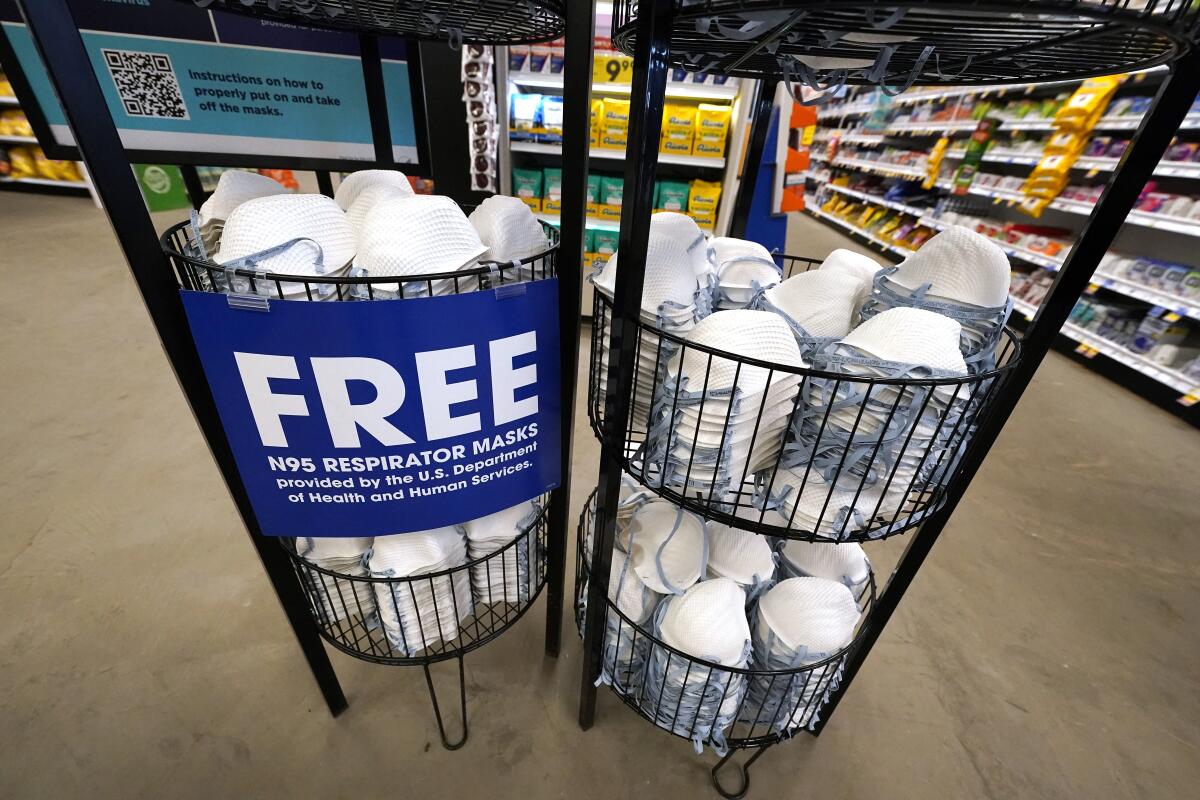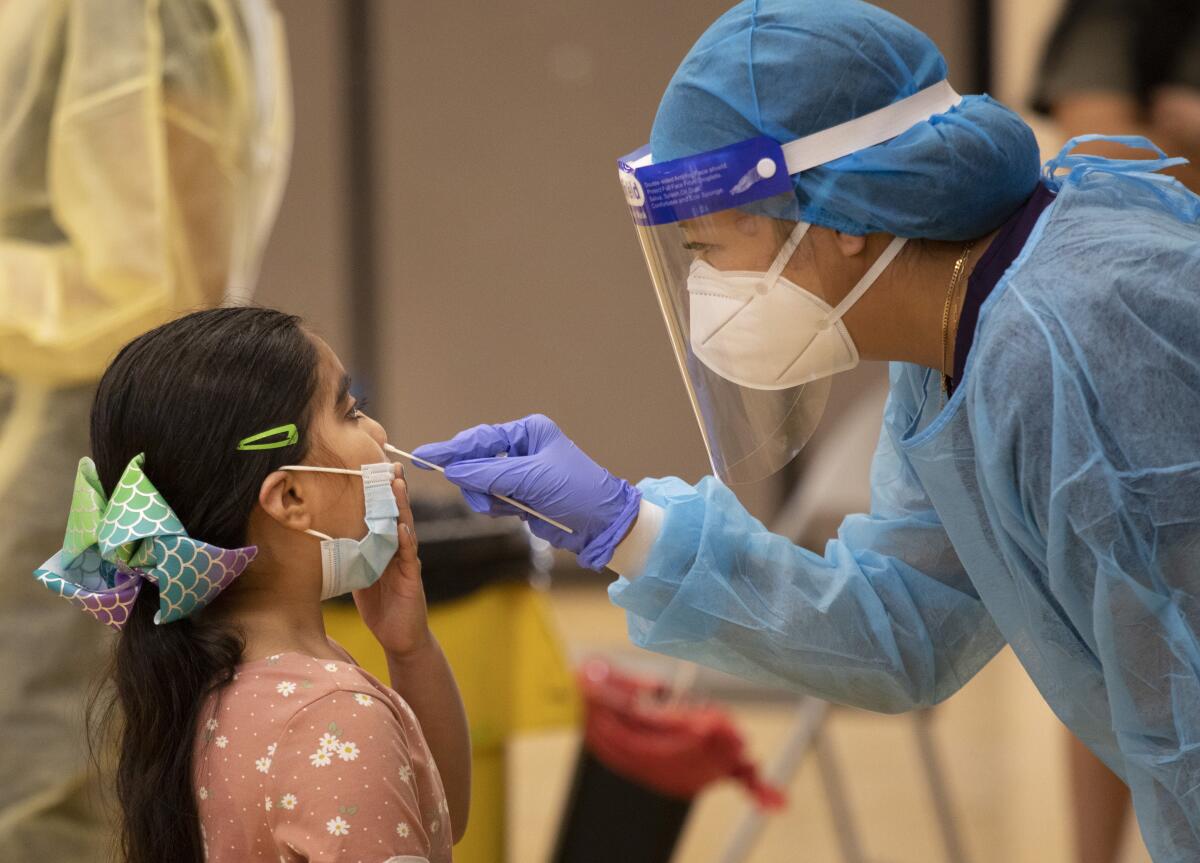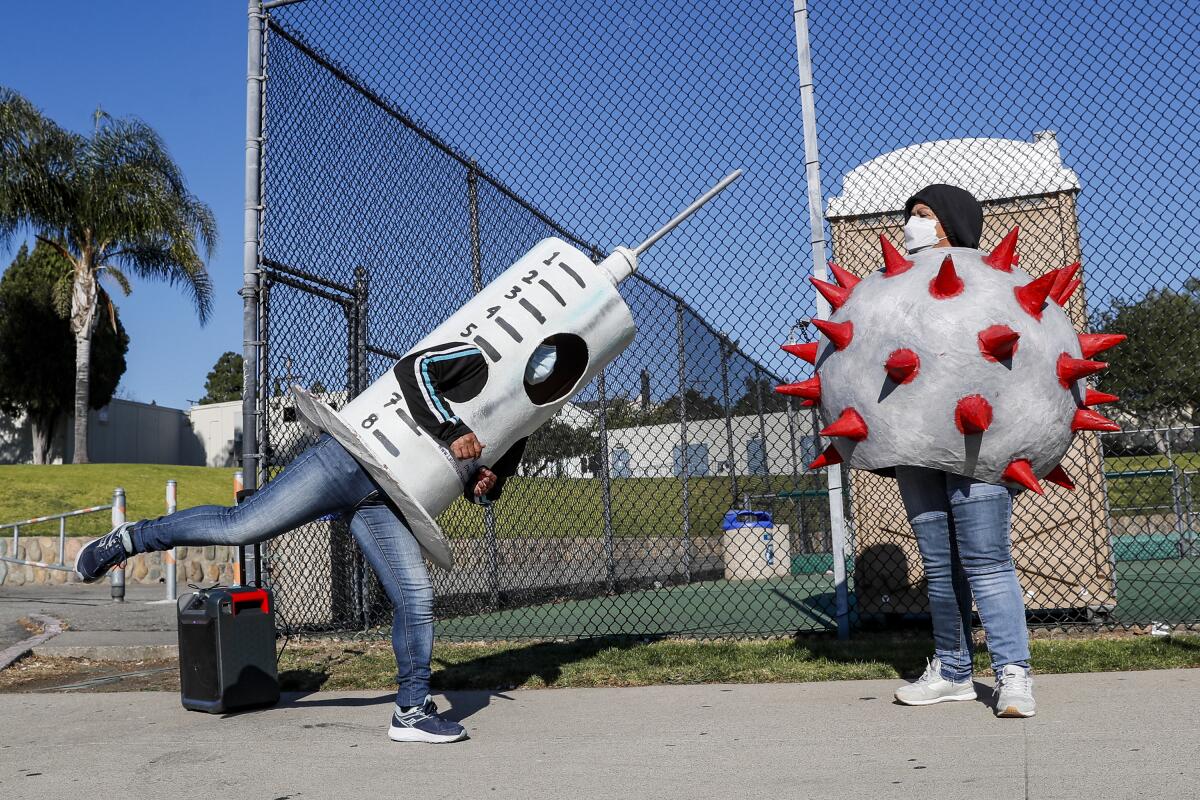Coronavirus Today: What we’ll lose when the health emergency ends
- Share via
Good evening. I’m Karen Kaplan, and it’s Tuesday, March 15. Here’s the latest on what’s happening with the coronavirus in California and beyond.
Everyone is eager for the pandemic to be over. But what about the nation’s public health emergency?
They sound like interchangeable terms, but they’re not the same thing.
The COVID-19 pandemic is a global outbreak of a novel infectious disease. In the United States, the public health emergency is a declaration by the government that our well-being is endangered by COVID-19 and the coronavirus that causes it.
Alex Azar, who served as secretary of the Department of Health and Human Services under President Trump, declared the public health emergency way back on Jan. 31, 2020, and made it retroactive to Jan. 27. That was mere weeks after the Chinese government informed the World Health Organization about a mysterious outbreak of pneumonia in Wuhan. The disease did not yet have a name, and the coronavirus was not yet known as SARS-CoV-2. It took about six more weeks for the WHO to label the outbreak a pandemic.
By declaring a public health emergency, Azar established a legal foundation for an array of government actions designed to respond to — and ideally contain — the virus. The initial declaration expired after 90 days and has been renewed continuously ever since. It will be up for renewal again April 15.
The public health emergency has one thing going for it that the pandemic doesn’t: It can be ended with the stroke of a pen.
Lots of Americans say they’re ready to see that happen. Among them are 76 Republicans in Congress who sent a letter to President Biden and Xavier Becerra, Azar’s successor, demanding that they begin the process of unwinding the public health emergency as soon as possible “so our country can get back to normal.”
That’s not likely to happen as soon as the lawmakers want. Even if it did, life wouldn’t exactly go back to the way things were in 2019, because the coronavirus is still among us.
But some things would go away, my colleague Melissa Healy reports.
For instance, the Biden administration would lose the clear legal authority to invoke the Defense Production Act to make companies produce pandemic necessities such as personal protective equipment. And the Centers for Disease Control and Prevention would give up its power to require that face masks be worn on airplanes, buses and other forms of public transit.
You might not lose much sleep over those things. You might even be happy to see them go.
But what about Paxlovid? That’s the new pill from Pfizer that can reduce the risk of severe COVID-19 by as much as 89%. The Food and Drug Administration issued an emergency use authorization for the pill in December, clearing the way for doctors to prescribe it to newly diagnosed patients.
Here’s the thing about emergency use authorizations: They’re only good while a public health emergency is in effect. When the emergency is over, the only drugs and medical devices that will still be available will be those that cleared the FDA’s usual — and lengthy — approval process.
Two COVID-19 vaccines are FDA-approved, but Comirnaty (the one made by Pfizer and BioNTech) is approved only for people 16 and older, and SpikeVax (the one made by Moderna) is approved only for adults. As things now stand, if the public health emergency ended tomorrow, no one under 16 would be able to get vaccinated.
Likewise, the only COVID-19 drug with full FDA approval so far is Veklury (aka remdesivir).

The public health emergency also makes COVID-19 vaccines, tests and treatments free to the public, because the government either picks up the tab or makes health insurance companies do so. Once the emergency is over, you may find yourself paying for things you’re used to getting for free.
Telemedicine took off during the pandemic, and when health insurance companies balked at paying for it, the government ordered them to cover virtual visits as if they had taken place in person. That was possible because of the public health emergency.
And while the declaration is in place, it’s much more difficult for states to remove people from their Medicaid rolls. If the health emergency is not renewed next month, nearly 13 million Americans are likely to lose their health coverage, according to an analysis from the Robert Wood Johnson Foundation and the Urban Institute.
“People have been wishing for back to normal, but you should be careful what you wish for,” said Georgetown University’s Lawrence Gostin, an expert in public health law. “This’ll be a whole new world.”
By the numbers
California cases and deaths as of 6:04 p.m. on March 15, 2022:

Track California’s coronavirus spread and vaccination efforts — including the latest numbers and how they break down — with our graphics.
How we’ll know if things get worse
In California, the number of new coronavirus cases reported each day has plunged 70% over the past two weeks, and daily COVID-19 deaths have fallen nearly 50% during the same period. Hopefully both trends will continue even as we ease up on mask mandates, vaccination requirements and other precautions.
But if they don’t, how will we know?
Los Angeles County health officials have a plan. They’ve devised a list of nine things to watch for an early indication of trouble, should it arise. They include:
New coronavirus cases: Unless all L.A. County residents are periodically screened for coronavirus infections, we can’t know exactly how many cases there are. But if a new outbreak gets underway, a signal should appear in the case data.
COVID-19 hospitalizations: This tells us whether a new outbreak is causing serious illnesses. If it does, the urgency to respond will be greater.
Emergency room visits: Officials want to know what percentage of ER visits involve COVID-19 patients. As long as it’s below 5% over the course of a week, their level of concern is low; if it rises above 10%, their level of concern will be high.
Viral variants: A portion of the coronavirus specimens collected from patients is selected for genetic sequencing. If a variant of concern arrives on the scene and is sequenced, health officials will be able to spot it. The county’s plan says if 5% or more of the specimens sent for sequencing turn out to be variants of concern (as designated by the WHO), it could portend a new surge. And if that figure exceeds 10%, it’s particularly worrisome.
Low-income areas: Health officials aren’t just interested in countywide metrics; they also want to keep tabs on the neighborhoods that have been hit hardest throughout the pandemic. Ideally, there will be fewer than 100 cases per 100,000 residents of low-income areas. If there are more than 200 cases per 100,000 residents, that would trigger high concern.
The four remaining indicators are specific settings where health officials are on the lookout for new outbreaks.
Schools: This includes elementary and secondary schools throughout the county. The goal is to see no more than three coronavirus outbreaks per week. If there are 10 are more, the level of concern would be high.
Skilled nursing facilities: The target for these places is no more than 10 outbreaks per week. If the number exceeds 20, health officials would be highly concerned.
Homeless shelters: The targets for these are the same as for skilled nursing facilities.
Work sites: Authorities would like to see fewer than 100 outbreaks each week. If there are more than 300, they’d be in highly concerned territory.
So how are we doing? According to the most recent data available, L.A. County is doing quite well, my colleagues Rong-Gong Lin II and Luke Money report.
As of Sunday, the only category that isn’t in the realm of low concern is schools. K-12 schools reported four outbreaks in the most recent week, just enough to generate a moderate level of concern. But looking on the bright side, those four outbreaks represent an improvement over the previous week, when there were seven.

Most of the other indicators are safely in the low-concern category. But a couple are somewhat close to the boundary with moderate concern. Last week, 4.3% of emergency room visits were coronavirus-related; as mentioned, the goal is to stay below 5%. Also, officials counted eight outbreaks in homeless shelters; the goal is not to exceed 10.
Having one indicator in the moderate range is something to keep an eye on. If two indicators enter that territory, “we’ll conduct an in-depth review of contributing factors and consider changes to community-prevention strategies,” said Barbara Ferrer, L.A. County’s director of public health.
In a worst-case scenario, such as the arrival of a new variant that’s impervious to the immunity we’ve received through vaccines and past infections, universal mask mandates and other rules could be reinstated.
California’s vaccination progress


See the latest on California’s vaccination progress with our tracker.
Your support helps us deliver the news that matters most.
In other news ...
At schools across California, students arrived Monday with the freedom to do something that hasn’t been possible all year: go without a face mask the entire day.
Not every school exercised its option to let students go mask-free. Los Angeles Unified, the largest district in the state, still has its mask mandate in place under a deal with the teachers union. And students in San Diego Unified have to keep their masks on until they return from spring break on April 4.
But for those who had a choice, the milestone day brought feelings of joy, relief, caution and uncertainty.
Giselle Frisby, a senior at Redondo Union High School in Redondo Beach, was somewhat distressed to find that only one of the four teachers she had Monday chose to wear a mask. Yes, they were optional, but state and county health officials strongly recommend that people continue to wear them. Giselle wore a surgical mask to protect herself from her unvaccinated classmates and for the sake of her dad, who has a medical condition.
Her classmate Jake Hatakeyama hates wearing a mask, especially while playing sports. He went mostly mask-free except for when he was near one of his teachers, who has a newborn at home.
More freedoms may be coming soon. Members of the Los Angeles City Council have taken the first steps toward lifting COVID-19 vaccine verification requirements for restaurants, salons, gyms, movie theaters and other businesses that are now required to confirm patrons’ vaccination status before serving them indoors.
Council members unanimously voted to draft an ordinance that would make vaccine verification voluntary instead of mandatory. The change would apply to operators of major outdoor events as well. Once the new ordinance is written, it will need to be approved in a future council meeting before it goes into effect.
Rules are being relaxed in other states as well. The governor of Hawaii announced plans to drop the nation’s last statewide indoor mask mandate by March 26.
And in April, the CDC will stop requiring everyone to wear a mask while taking any form of public transit or while in a transportation hub, such as an airport or a subway station. That broad mandate will be replaced with more targeted policies, officials said.
The U.S. is looking more and more like Europe, where countries have been dropping pandemic restrictions for weeks. France joined them Monday by doing away with the need for masks in most settings and allowing people to dine out, ride trains, go to theaters and attend sporting events without having to flash a vaccine pass.
France’s move came even though the number of new infections there is once again on the rise. The country is averaging more than 60,000 new cases per day over the past week, up from about 50,000 a week earlier. The United Kingdom and other European nations are also seeing their cases rise.
That has some health experts fearing the same will happen in the U.S. this spring.
“As we have seen throughout the pandemic, the U.S. [has] followed Europe by several weeks in our waves of cases. That may happen again here,” Andy Slavitt, a former senior adviser to President Biden’s pandemic response team, wrote on Twitter.
Slavitt attributed the rise in European cases to BA.2, a sublineage of Omicron that spreads about 30% faster than the still-dominant BA.1. According to the CDC’s most recent estimate, BA.2 accounts for about 23% of coronavirus specimens in the U.S., up from about 14% the week before and just 7% the week before that.
Dr. Eric Topol, director of the Scripps Research Translational Institute in La Jolla, said waning immunity and a relaxation of safety rules also factored into Europe’s rising caseload. If so, that’s even more ominous for the U.S.
Speaking of waning immunity, Pfizer is expected to ask the FDA to authorize a second COVID-19 booster dose for senior citizens, according to a person familiar with the matter. Among all age groups, seniors have experienced the highest COVID-19 death rates by far, especially people who are 75 and older. If the FDA authorizes another booster, the CDC would have to sign off as well.
On a related note, L.A. County has launched the “test to treat” COVID-19 program introduced by President Biden during his recent State of the Union address. People who test positive for a coronavirus infection at a participating CVS health clinic can get one of two types of anti-COVID pills — either Paxlovid or a less-effective drug made by Merck & Co. called molnupiravir — for free. Both pills work best when taken as soon after possible after an infection. More information about the program is available online or by calling (833) 540-0473.
On to Asia, where the pandemic picture looks very different than it does here. The latest update from the WHO says the Western Pacific region saw coronavirus cases jump 46% week-to-week, even as infections dropped 5% for the planet as a whole. In addition, while global COVID-19 deaths fell 8%, deaths in the Western Pacific rose 29%.
China, the largest country in the region, said it recorded 3,507 new cases on Tuesday. That’s more than double the 1,337 new cases it tallied on Monday. Altogether, the country has announced more than 10,000 cases so far in March, making it China’s biggest outbreak by far since the initial days of the pandemic.
Nearby, South Korea experienced its deadliest day of the pandemic on Tuesday, with 293 casualties. An additional 1,196 COVID-19 patients are in serious or critical condition. Health officials there expect the situation to get worse.
COVID-19 isn’t done with Americans, either. In just the past few days, both former President Obama and Doug Emhoff, the husband of Vice President Kamala Harris, tested positive for coronavirus infections.
Your questions answered
Today’s question comes from readers who want to know: What is Deltacron, and do I need to worry about it?
Deltacron is the nickname of a new version of the coronavirus that’s a mishmash of the Delta and Omicron variants.
Although these strains were responsible for the last two surges, officials say the hybrid is nothing to worry about right now.
Only a handful of Deltacron infections have been documented nationwide, Dr. Erica Pan, the state epidemiologist, told the California Medical Assn. At least one of those cases was in the Golden State, she said.
As of Friday, the combo variant had not been detected in L.A. County, Ferrer said. In fact, she added, it’s too scarce to get a handle on whether it’s resistant to existing vaccines and treatments.
California health officials aren’t the only ones taking Deltacron in stride. Neither the CDC nor the WHO has seen fit to designate it a variant of concern, or even a variant of interest. To qualify for one of those labels, Deltacron would need to be causing clusters of infections in multiple countries. It would also need to have genetic mutations that make it behave (or are suspected to make it behave) in a way that’s distinct from its predecessors.
We want to hear from you. Email us your coronavirus questions, and we’ll do our best to answer them. Wondering if your question’s already been answered? Check out our archive here.
The pandemic in pictures

I’d like to give a shoutout to the enterprising folks in the photo above.
Socorro Juarez is the one on the left, dressed as a syringe. Rosa Cardona is on the right, dressed as a coronavirus. My colleague Robert Gauthier spotted them a few weeks ago in San Juan Capistrano.
At least once a week, the pair don their costumes in an effort to persuade fellow Latinos to get vaccinated against COVID-19. According to the Times’ tracker, 46% of Latinos in California aren’t fully vaccinated, including the 38% who have yet to receive their first shot.
Resources
Need a vaccine? Here’s where to go: City of Los Angeles | Los Angeles County | Kern County | Orange County | Riverside County | San Bernardino County | San Diego County | San Luis Obispo County | Santa Barbara County | Ventura County
Practice social distancing using these tips, and wear a mask or two.
Watch for symptoms such as fever, cough, shortness of breath, chills, shaking with chills, muscle pain, headache, sore throat and loss of taste or smell. Here’s what to look for and when.
Need to get a test? Testing in California is free, and you can find a site online or call (833) 422-4255.
Americans are hurting in various ways. We have advice for helping kids cope, as well as resources for people experiencing domestic abuse.
We’ve answered hundreds of readers’ questions. Explore them in our archive here.
For our most up-to-date coverage, visit our homepage and our Health section, get our breaking news alerts, and follow us on Twitter and Instagram.




